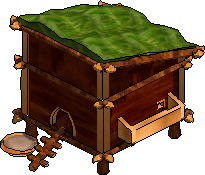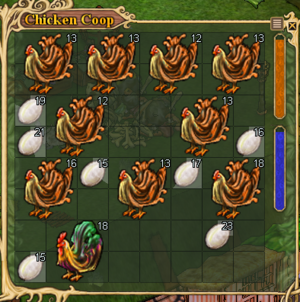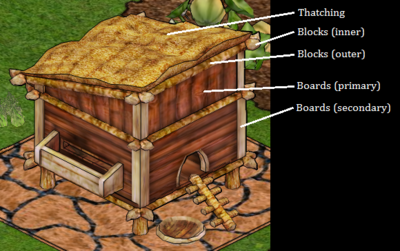Chicken Coop
| Chicken Coop | |
|---|---|

| |
| Vital statistics | |
| Size (obj)Structure footprint in tile units.<br><br><i>Rounded-up from source.<br>Source: 1.98 x 1.98</i> | 2 x 2 |
| Storage Size | 8 x 8 |
| Skill(s) RequiredSpecific needed skills that enable a given object or item. | Animal Husbandry |
| Discovery Req.This(<i>discoveryreq</i>) is only for items that need to be discovered in addition to items listed in "Object(s) Required"/<i>(<i>objectsreq</i>).</i><small><br><b><i>(Temporary active on all pages, but leave empty if "None".</i></b><small> | (None or Unknown) |
| Object(s) Required | Board x15, Block of Wood x10, Straw x5, Thatching Material x10 |
| Required By | (4) Chick, Chicken Egg, Gold Egg, Swill |
| Repaired With | Board |
| Can be Lifted | No |
| Has Quality | No |
| Go to Objects | |
![]() Build > Buildings & Construction > Houses & Buildings > Chicken Coop
Build > Buildings & Construction > Houses & Buildings > Chicken Coop
If you want to breed Hens and Cocks you will need to build a Chicken Coop. Each hen will take around 1 real life day to lay an Egg. Be sure to leave space below the hen or it will not produce an egg. Hens will lay eggs without a cock in the Chicken Coop, but they will not be fertilized. Fertilized eggs have a white pie fraction overlain on them indicating when they will hatch into chicks. Fertilized eggs can still be turned into food, such as Fried Egg.
Chicken Coops offer an 8x8 inventory grid. Note that Hens, which take up 4 spaces (2x2), must have at least one space directly below them to lay eggs. Likewise fertilized eggs must be under the hens for them to hatch. The game checks this from time to time, and will turn a fertilized egg immediately into a unfertilized egg if it finds no chicken above the egg. Chicks must have a 2x2 tile space, a total of 4 tiles, to mature into chickens and they will jostle themselves around to make this room when they are ready, however, if it is not available their timer will pause and they will not mature until there is enough room.
Note that very fresh fertilized eggs don't show there hatching timer for some time.
Quality
A Chicken Coop has no quality and thus has no effect on the eggs and chicks produced.
Essentially, chicken quality is directly based on water and seed quality. Higher quality fodder, known as Swill in game, from higher quality foods will allow your chicks to grow into higher quality hens and cocks; Higher quality cocks and hens will produce higher quality eggs, which will hatch into higher quality chicks than the previous generation, and thus the cycle repeats.
Chickens and Chicks will degrade down in quality if they can't find food, or there food is below their own quality.
When a new egg is laid, it's quality is based on the average of its parents quality +/-5. When it hatches the chick is initially of the same quality as its egg was. As the young chick grows, it will feed occasionally. If during any of these feedings fodder and water quality's average is lower than that of said chick, then the chick's quality will drop by some increment.
Caring for your Chickens
Chickens require feeding and watering and Chicken Coops have space inside for this. To fill them, have fodder material (listed below) in your inventory, then lift it up with a left-click and right-click on the coop. This will fill the fodder bar a bit. You will not be able to recover any seed or plants used in this manner. Fodder and water each fill up their own meter inside the coop. As the chickens eat, the amounts that will be diminished are proportionate to the number of chickens contained therein.
Chicken Coops can hold a maximum of 30.00(L) of water and 30.00(L) of swill.
Chicks consumes 0.05 Swill and Water per RL day.
Grown adults consumes ??? Swill and Water per RL day.
See Swill page for list of plants that can be used as fodder.
Hens captured from the wild seem to have an extended (24 RL hours???) "adjustment" -period after being placed in a coop, during which they will not lay eggs, but consume neither water or fodder.
How to Acquire
A Chicken Coop can be built, generally on a 2x2 paved area.
Appearance
Tips
- There is a trick to filling a Chicken Coop much more quickly than normal. Click to pick up a unit of food, then with it floating on your cursor, hold down the shift key and right click the trough. As long as you keep the shift key held down, another unit of food from your inventory will automatically be placed on your cursor, ready to right click again!
- Warning: Edible forageables, like for example, Candleberry or Bloated Bolete also count as fodder, so be careful when shift-right clicking as you will loose them.
- The Chicken Coop can also be filled directly using a Wheelbarrow, Bucket, or Food Trough.
- Any fodder placed in Chicken Coop will turn into generic Swill.
- Swill can be taken out by right-clicking Coop with Bucket, Barrel, or Trough and transferred freely between all of them.
- Water can be taken out of coop with bucket or barrel if the coop has no swill in it. Alternatively, if the coop still has some swill in it, a barrel with some water in it, while the coop is fully filled with water, will also do the trick (Mind you. This will of course mix the water quality if those are not the same).
Chicken Coop factory
Having just one chicken coop is general not very efficient.
Depending on your target multiple coops are usually the way to go.
For quality upgrading using three coops is the basic way to go.
- Coop 1: The breeding coop with chickens(10 max) and one Rooster. Target: Generating fertilized eggs. (seemingly unfertilized eggs are best not moved yet)
- Coop 2: The hatching coop with 8 chickens in two rows (no rooster). Target: Hatching fertilized eggs. The quality of the chickens used here doesn't matter.
- Coop 3: The maturing coop for letting hatched chicks mature. (+optional storage of backup rooster)
This setup will produce both eggs, for cooking, and chickens, for slaughtering, in relative high quantities. While allowing raising the overall chicken quality relatively fast.

Notes
- (winter) An active rabbit hutch is also a heat source. And will melt snow around it in a circle of ~4.5 tiles.
Game Development
- Color Wheel (2024-05-27)◎ >"Reduced building cost of Rabbit Hutch, Chicken Coop, Dovecote, Log Cabin, and Timber House."

